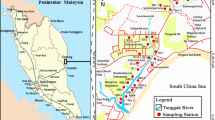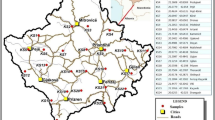Abstract
The concentrations of metals (Pb, Cr, Ba, Zn, V, Mn, Co, Cu, Ni and As) in 38 soil samples collected from the industrial district in Weinan (NW China) were determined by wavelength dispersive X-ray fluorescence spectrometry. The magnetic parameters of soil including low-/high-frequency susceptibility and frequency-dependent susceptibility were measured. The modified three-step BCR sequential extraction procedure was used to evaluate mobility, availability and persistence of trace elements in urban soil samples. Multivariate (principal component analysis, clustering analysis and correlation analysis) and geostatistical analysis (ArcGIS tools) were applied to the obtained data to evaluate the analytical results and to identify the possible pollution sources of metals as well as geo-spatial distributions. The results revealed that the sampling area was mainly influenced by two main sources: (1) Ba, Cu, Pb, Cr and Zn were mainly derived from industrial sources, which combined with coal combustion as well as traffic factor. The mobility sequence based on the sum of the BCR sequential extraction stages was: Pb (53.79 %) > Zn (51.78 %) > Cu (50.96 %) > Ba (42.59 %) > Cr (18.47 %). Pb was the metal predominantly associated (~46.86 %) with the form bound to Fe/Mn oxides, and the highest percentage of Zn was exchangeable and carbonate-bound fraction. Cu was present mainly in organic fraction, while the residual fraction was the most dominant solid phase pool of Cr (~81.53 %) and Ba (~57.41 %). (2) Mn, V, Co, As and Ni in the study area were consistently from natural sources. The analysis of enrichment factors indicated that urban soils in Weinan City were classified as having significant enrichment by Ba, Cu, Pb, Cr and Zn. The overall results proposed the future tactics for Weinan environment quality control on a local scale that concerned not only the levels of risky, but also the industrial emission abatement techniques as well as urban setting.







Similar content being viewed by others
References
Acosta JA, Faz SA, Martínez M, Zornoza R, Carmona DM, Kabas S (2011) Multivariate statistical and GIS-based approach to evaluate heavy metals behavior in mine sites for future reclamation. J Geochem Explor 109:8–17
Badal K, Kazuo T (2002) Arsenic round the world: a review. Talanta 58:201–235
Banerjee ADK (2003) Heavy metal levels and solid phase speciation in street dusts of Delhi, India. Environ Pollut 123:95–105
Barbara A, Reginald M, Taylor M (1998) Formation of ultrafine-grained magnetite in soils. Nature 324:368–370
CNEMC (China National Environmental Monitoring, Centre) (1990) The background values of chinese soils. Environmental Science Press of China, Beijing
CNEPA (China National Environmental Protection Agency) (2004) The technical specification for soil environmental monitoring, HJ/T 166-2004
Davis HT, Aelion CM, McDermott S, Lawson AB (2009) Identifying natural and anthropogenic sources of metals in urban and rural soils using GIS-based data, PCA, and spatial interpolation. Environ Pollut 157:2378–2385
De Miguel E, Llamas JF, Chacón E, Berg T, Larssen S, Royset O, Vadset M (1997) Origin and patterns of distribution of trace elements in street dust: unleaded petrol and urban lead. Atmos Environ 31:2733–2740
El Nemr A, Khaled A, El Sikaily A (2006) Distribution and statistical analysis of leachable and total heavy metals in the sediments of the Suez Gulf. Environ Monit Assess 118:89–112
Fang G, Wu Y, Chang S, Huang S, Rau J (2006) Size distributions of ambient air particles and enrichment factor analyses of metallic elements at Taichung Harbor near the Taiwan Strait. Atmos Res 81:320–333
Fernández-Caliani JC, Barba-Brioso C, González I, Galán E (2009) Heavy metal pollution in soils around the abandoned mine sites of the Iberian Pyrite Belt (southwest Spain). Water Air Soil Pollut 200:211–226
Goovaerts P (1999) Geostatistics in soil science: state-of-the-art and perspectives. Geoderma 89:1–45
Han Y, Du P, Cao J, Posmentier ES (2006) Multivariate analysis of heavy metal contamination in urban dusts of Xi’an, central China. Sci Total Environ 355:176–186
Hanesch M, Scholger R (2002) Mapping of heavy metal loadings in soils by means of magnetic susceptibility measurements. Environ Geol 42:857–870
Jiries AG, Hussein HH, Halash Z (2001) The quality of water and sediments of street runoff in Amman. Jordan Hydrol P 15:815–824
Kabala C, Singh BR (2001) Fractionation and mobility of copper, lead and zinc in soil profiles in the vicinity of a copper smelter. J Environ Qual 30:485–492
Kartal S, Aydın Z, Tokalıoglu S (2006) Fractionation of metals in street sediment samples by using the BCR sequential extraction procedure and multivariate statistical elucidation of the data. J Hazard Mater 132:80–89
Lee C, Li X, Shi W, Cheung S, Thornton I (2006) Metal contamination in urban, suburban, and country park soils of Hong Kong: a study based on GIS and multivariate statistics. Sci Total Environ 356:45–61
Li X, Feng L (2010) Spatial distribution of hazardous elements in urban topsoils surrounding Xi’an industrial areas (NW, China): Controlling factors and contamination assessments. J Hazard Mater 174:662–669
Li X, Huang C (2007) Environment impact of heavy metals on urban soil in the vicinity of industrial area of Baoji city, P.R. China. Environ Geol 52:1631–1637
Li X, Thornton I (2001) Chemical partitioning of trace and major elements in soils contaminated by mining and smelting activities. Appl Geochem 16:1693–1706
Li F, Fan Z, Xiao P, Oh K, Ma X, Hou W (2009) Contamination, chemical speciation and vertical distribution of heavy metals in soils of an old and large industrial zone in northeast China. Environ Geol 57:1815–1823
Loredo J, Ordoñez A, Charlesworth S, De Miguel E (2003) Influence of industry on the geochemical urban environment of Mieres (Spain) and associated health risk. Environ Geochem Health 25:307–323
Lu X, Loretta Li Y, Wang L, Lei K, Huang J, Zhai Y (2009a) Contamination assessment of mercury and arsenic in roadway dust from Baoji, China. Atmos Environ 43:2489–2496
Lu X, Wang L, Lei K, Huang J, Zhai Y (2009b) Contamination assessment of copper, lead, zinc, manganese and nickel in street dust of Baoji, NW China. J Hazard Mater 161:1058–1062
Marco TG, Joaquín D, Stefano A, José MN, Annamaria L, Benedetto DV (2011) Environmental geochemical mapping of Huelva municipality soils (SW Spain) as a tool to determine background and baseline values. J Geochem Explor 109:59–69
Martinez J, Llamas JF, De Miguel E (2008) Soil contamination from urban and industrial activity: example of the mining district of Linares (southern Spain). Environ Geol 54:669–677
Miriam KR, Spencer KL, Laura S (2011) An appraisal of microwave-assisted Tessier and BCR sequential extraction methods for the analysis of metals in sediments and soils. J Soils Sediment 3:518–528
Mossop KF, Davidson CM (2003) Comparison of original and modified BCR sequential extraction procedures for the fractionation of copper, iron, lead, manganese and zinc in soils and sediments. Anal Chim Acta 478:111–118
Mustafa S, Dundar H, Altundag V, Eyupoglu S, Keskin C, Thornsun C (2012) Determination of heavy metals in lower Sakarya river sediments using a BCR-sequential extraction procedure. Environ Monit Assess 184:33–41
Ozan DY, Omar A, Gurdal T (2008) Multivariate statistics to investigate metal contamination in surface soil. J Environ Manag 86:581–594
Querol X, Viana M, Alastuey A, Amato F, Moreno T (2007) Source origin of trace elements in PM from regional background, urban and industrial sites of Spain. Atmos Environ 41:7219–7231
Raab GA, Bartling MH, Stapanian MA, Cole WH, Tidwell RL, Cappo KA (1990) The homogenization of environmental soil samples in bulk. In: Simmons MS (ed) Hazardous waste measurements. Lewis Publishers, Chelsea, p 35–52
Ramos L, Hernandez M, Gonzalez MJ (1994) Sequential fractionation of copper, lead, cadmium and zinc in soils from or near Donana National Park. J Environ Qual 23:50–57
Rauret G, Lopez-Sanchez JF, Sahuquillo A, Rubio R, Davidson C, Ure A, Quevauviller Ph (1999) Improvement of the BCR three step sequential extraction procedure prior to the certification of new sediment and soil reference materials. J Environ Monit 1:57–61
Rehman W, Zeb A, Noor N, Nawaz M (2008) Heavy metal pollution assessment in various industries of Pakistan. Environ Geol 55:353–358
Samara C, Kouimtzis TH, Tsitouridou R, Kanias G, Simeonov V (2003) Chemical mass balance source apportionment of PM10 in an industrialized urban area of northern Greece. Atmos Environ 37:41–54
Serife T, Senol K (2006) Multivariate analysis of the data and speciation of heavy metals in street dust samples from the organized industrial district in Kayseri (Turkey). Atmos Environ 40:2797–2805
Shah MH, Shaheen N (2007) Statistical analysis of atmospheric trace metals and particulate fractions in Islamabad, Pakistan. J Hazard Mater 147:759–767
UN (2010) World urbanization prospects: the 2009 revision. United Nations Department of Economic and Social Affairs/Population Division, Washington
Watson JG, Chow JC, Houck JE (2001) PM2.5 chemical sources profiles for vehicle exhaust, vegetative burning, geological material and coal burning in northwestern Colorado during 1995. Chemosphere 43:1141–1151
Xia DS, Yu Y, Ma JY, Wang G, Yang LP, Jin M, Liu XM, Chen FH (2007) Magnetic characteristics of street dust in Lanzhou and its environmental significance. Environ Sci 28:937–944
Xia X, Chen X, Liu R, Liu H (2011) Heavy metals in urban soils with various types of land use in Beijing, China. J Hazard Mater 186:2043–2050
Xing G, Zhu J (2003) Soil chemistry of trace element and rare earth element. China Science Press, Beijing
Yang P, Mao R, Shao H (2009) An investigation on magnetic susceptibility of hazardous saline-alkaline soils from the contaminated Hai River Basin, China. J Hazard Mater 172:494–497
Yang Z, Lu W, Long Y, Bao X, Yang Q (2011) Assessment of heavy metals contamination in urban topsoil from Changchun City, China. J Geochem Explor 108:27–38
Yongming H, Peixuan D, Junji C, Posmentier ES (2006) Multivariate analysis of heavy metal contamination in urban dusts of Xi’an, Central China. Sci Total Environ 355:176–186
Zhang XY, Lin FF, Mike TF, Wong Feng XL, Wang K (2009) Identification of soil heavy metal sources from anthropogenic activities and pollution assessment of Fuyang County, China. Environ Monit Assess 154:439–494
Acknowledgments
Financial support was from Fundamental Research Funds for the Central Universities (GK200902024) and National Natural Science Foundation of China. The authors sincerely appreciate the 2007 Fellowship of Chemistry Department, Jackson State University, provided by Dr. Paresh Chandra Ray (Professor in Physical Chemistry, Jackson State University) and Dr. Hongtao Yu (Chair of Department of chemistry, Jackson State University). Many thanks should be given to scientific journal editors and many anonymous referees for previewing and English writing. Opinions in the paper do not constitute an endorsement or approval by the funding agencies and only reflect the personal research views of the authors.
Author information
Authors and Affiliations
Corresponding author
Rights and permissions
About this article
Cite this article
Li, X., Feng, L. Geostatistical analyses and fractionation of heavy metals in urban soil from industrial district in Weinan, NW China. Environ Earth Sci 67, 2129–2140 (2012). https://doi.org/10.1007/s12665-012-1653-8
Received:
Accepted:
Published:
Issue Date:
DOI: https://doi.org/10.1007/s12665-012-1653-8




